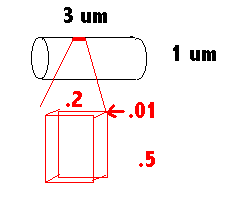![]() web.pdx.edu/~rueterj/bi445/notes/ultrastructure.htm
web.pdx.edu/~rueterj/bi445/notes/ultrastructure.htm
The following is an example for the composition of an cyanobacterial cell.
The cell has a diameter of 1 um and a length of 3 um (cylindrical)
The total volume of the cell is um^3 cell^-1
The total mass g cell^-1
The dry mass g cell^-1
carbon content moles C cell^-1
moles of carbon per cell = 21 fmol C cell^-1 ( 21 x 10^-12 moles C per cell)
| functional component | % of mass | mol C cell^-1 |
| Structure | 20% | 4 |
| Photosythetic stuff | 35% | 7 |
| Enzymatic and biosynthetic | 40% | 8 |
| Reserve | 5% | 1 |
Make a slice through this that is 0.5 um x .1 um x .01 um (this equals 5 x 10-4 um^3 or 2 x 10^-4 of the total cell volume)

Each of these slices should have the following components
| component | % of cell | number of "objects" | size of each "object" | |
| S | lipopolysacc | 2 | 1 layer | about 32 nm |
| murein layer | 3 | 1 layer | ||
| lipid in plasmalemma membrane | 10 | 1 layer | 6 to 7 nm | |
| DNA | 5 | portion of the strand | 100 nm | |
| P | lipid in thylakoid membranes | 15 | 4 to 7 layers | 6 to 7 nm each |
| protein in the membrane | 15 | at least 150 |
PSI is 9 x 7 nm |
|
| soluble Calvin cycle enzymes | 4 | at least 50 | many are 40,000 daltons or greater ( 10 nm) | |
| E | RNA in ribosome, tRNA and mRNA | 20 | at least 6 ribosomes at least 80 tRNA |
70S ribosomes 21 x 29 nm |
| Protein as soluble enzymes | 20 | at least 200 | MR = 40,000 daltons 10 nm |
|
| R | glycogen | 5 | ? | |
If you layed this out on your desk at 1,000,000 time magnification, the 0.5 um would be 0.5 meters (about 19 inches) and the 0.2 um would then be about 8 inches. Imagine two 81/2 by 11 sheets of paper taped together with a 3 " overlap.